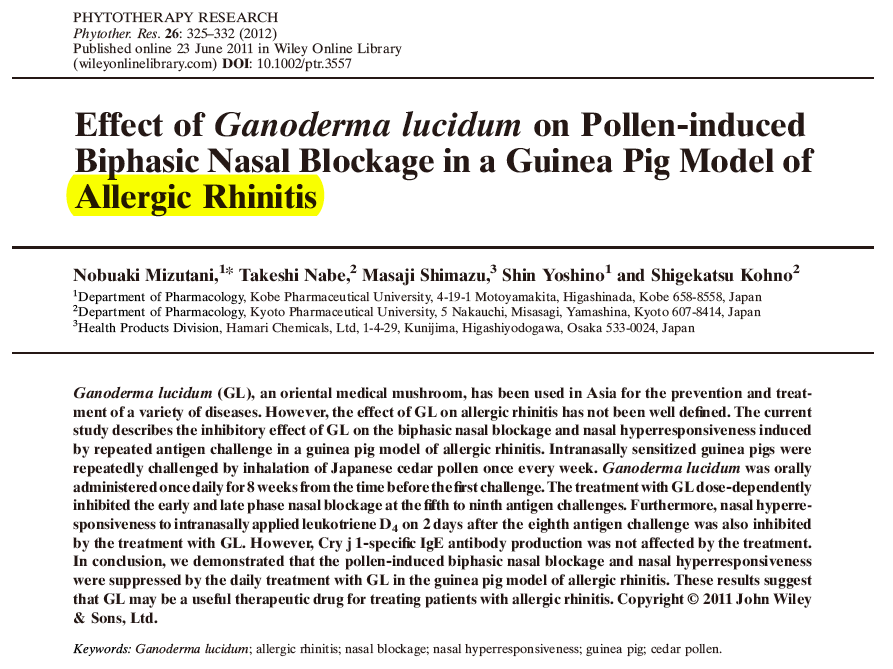June 23, 2011 / Kobe Pharmaceutical University / Phytotherapy Research
Text/ Wu Tingyao

Nasal obstruction, itchy nose, sneezing and runny nose are common symptoms of “allergic rhinitis”, and pollen is one of the allergens of allergic rhinitis. During the flowering season, someone enjoys the flowers, but someone hates his nose. Perhaps eating Ganoderma lucidum patiently can make allergic noses less allergic.
A research report published by the Department of Pharmacology of Kobe Pharmaceutical University in Japan in “Phytotherapy Research” in 2011 used guinea pigs as experimental subjects. The researchers first made guinea pigs inhale pollen intensively within a week to form an allergic physique. After a week interval, they made the guinea pigs inhale pollen once a day to induce nose allergies. And, two days before the guinea pigs “inhale pollen”, the researchers began to feed the guinea pigs Ganoderma lucidum fruiting body powder (Containing 7.5% chitin and 40% Ganoderma lucidum polysaccharide) at a dose of 100 or 1,000 mg per kilogram of body weight per day for eight weeks.
It was found that compared with the guinea pigs that were not protected by Ganoderma lucidum, the group of guinea pigs that had Ganoderma lucidum had significantly reduced their nasal congestion symptoms from the fifth week (high doses lead to better results); the number of sneezes was also reduced (the effect of low doses is similar to that of high dose).
Even if the researchers used leukotriene (one of the inflammatory mediators that cause allergic reactions) to aggravate the irritation in the later stage of the experiment, the group that ate high-dose Ganoderma lucidum had been less affected on nose breathing.
Experiments also found that after stopping the use of Ganoderma lucidum, if the guinea pigs are continuously exposed to allergens, the effect of Ganoderma lucidum in reducing nasal congestion still exists in the first week, but by the second week, the situation of nasal congestion is as worse as that of those guinea pigs who did not eat Ganoderma lucidum.
In addition, taking Ganoderma lucidum for a short period of time is not effective, because researchers have tried to feed guinea pigs with rhinitis symptoms for one and a half months with a high dose of Ganoderma for a week, but Ganoderma lucidum has not been able to improve the nasal congestion of the guinea pigs.
This research reminds us that Ganoderma lucidum can improve allergic rhinitis, but such improvement cannot be done overnight. Ganoderma lucidum will show its effects when taken for a certain period of time and continue to be effective when taken uninterruptedly. In this experiment, it was “not” observed that Ganoderma lucidum can reduce the amount of IgE, which shows that Ganoderma lucidum has an obvious effect of “inhibiting inflammation” in the improvement of allergic symptoms in the initial stage. It may take more time to adjust physical fitness through Ganoderma lucidum, and it is better to stay away from allergens.
As for why researchers choose guinea pigs for experiments? Because they do not breathe with their mouths, the accuracy of the experimental results is greatly improved.

[Source] Mizutani N, et al. Effect of Ganoderma lucidum on pollen-induced biphasic nasal blockage in a guinea pig model of allergic rhinitis. Phytother Res. 2012 Mar;26(3):325-32. doi: 10.1002/ptr.3557. Epub 2011 Jun 23.
END
About the author/ Ms. Wu Tingyao
Wu Tingyao has been reporting on first-hand Ganoderma lucidum information since 1999. She is the author of Healing with Ganoderma (published in The People’s Medical Publishing House in April 2017).
★ This article is published under the exclusive authorization of the author
★ The above works cannot be reproduced, excerpted or used in other ways without the authorization of the author
★ Violation of the above statement, the author will pursue its related legal responsibilities
★ The original text of this article was written in Chinese by Wu Tingyao and translated into English by Alfred Liu. If there is any discrepancy between the translation (English) and the original (Chinese), the original Chinese shall prevail. If readers have any questions, please contact the original author, Ms. Wu Tingyao.



